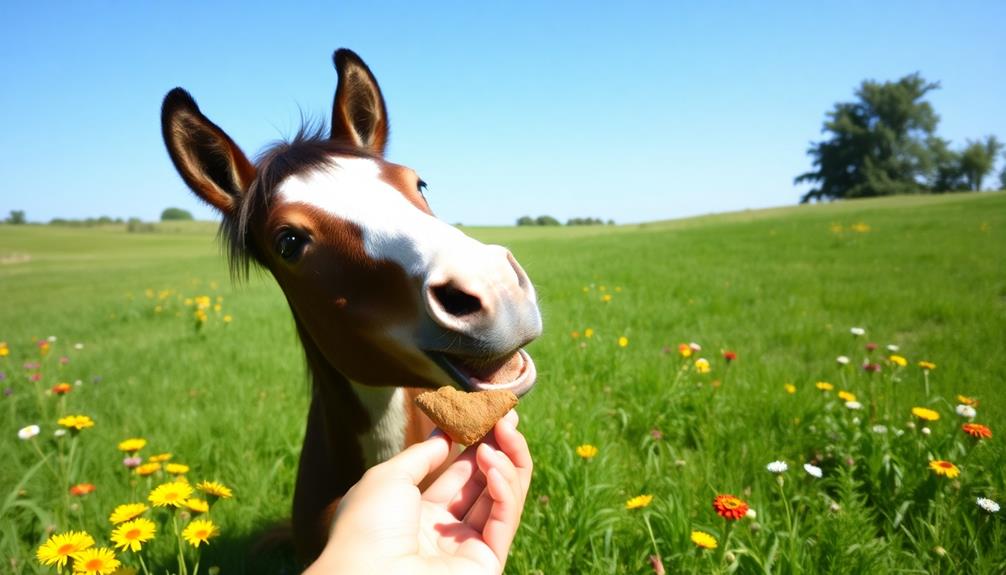When your miniature horse is expecting, you can expect around 330 days of gestation. Keep an eye on her belly size and behavior. A balanced diet is crucial, so feed her quality hay and grain. As the big day approaches, watch for signs like changes in milk texture and increased rolling. Foaling usually lasts 20-30 minutes, so be ready to assist if it's delayed. After birth, your foal needs to nurse within a few hours for colostrum. Maintaining their bond is significant, and proper care guarantees both will thrive. There's much more to explore about this exciting journey ahead!
Key Takeaways
- Miniature horse gestation lasts approximately 330 days, with variations from 10 months to over a year.
- Monitor for signs of foaling, such as changes in milk texture and mammary gland filling.
- Ensure the mare receives a balanced diet, including appropriate hay and grains throughout pregnancy.
- Post-birth, the foal should nurse within 2-3 hours to obtain essential colostrum for immunity.
- Regular health checks for both mare and foal are crucial for early identification of any issues.
Understanding Miniature Horse Pregnancy
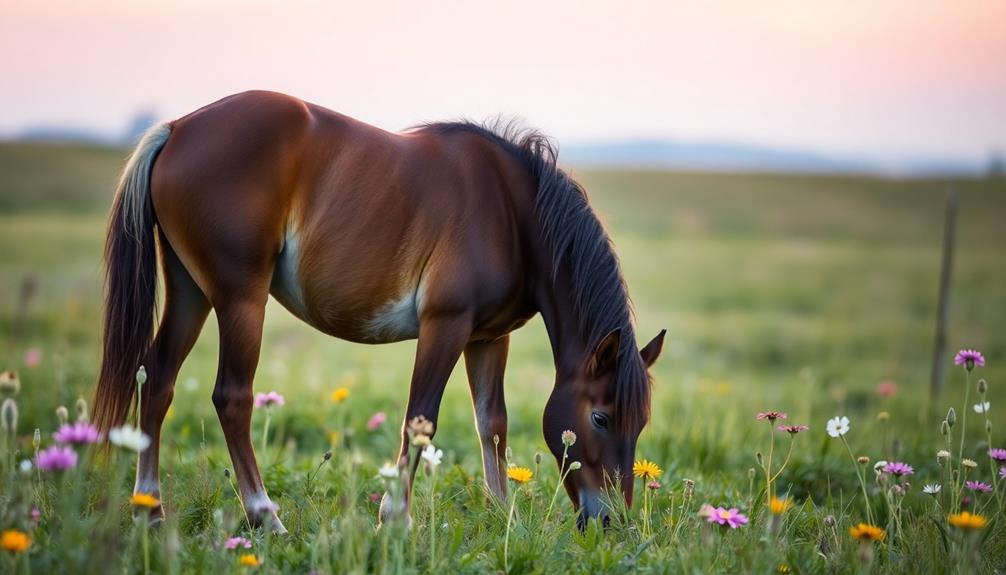
Understanding Miniature Horse Pregnancy is important for any owner looking to care for a pregnant mare. Typically, miniature horses have a gestation period averaging around 330 days, but it can range from 10 months to over a year depending on the individual mare.
To estimate the due date, keep track of the last breeding date and monitor changes in the mare's belly size and shape.
During this time, it's essential to provide a balanced diet that includes non-fescue grass hay and appropriate grain to meet the nutritional needs of both the mare and foal. Regular veterinary check-ups are important to guarantee both the mare and developing foal remain healthy throughout the pregnancy.
As the due date approaches, close observation for signs of impending foaling becomes critical. You should look for mammary gland development and changes in milk consistency in the last few days before delivery.
Signs of Imminent Foaling
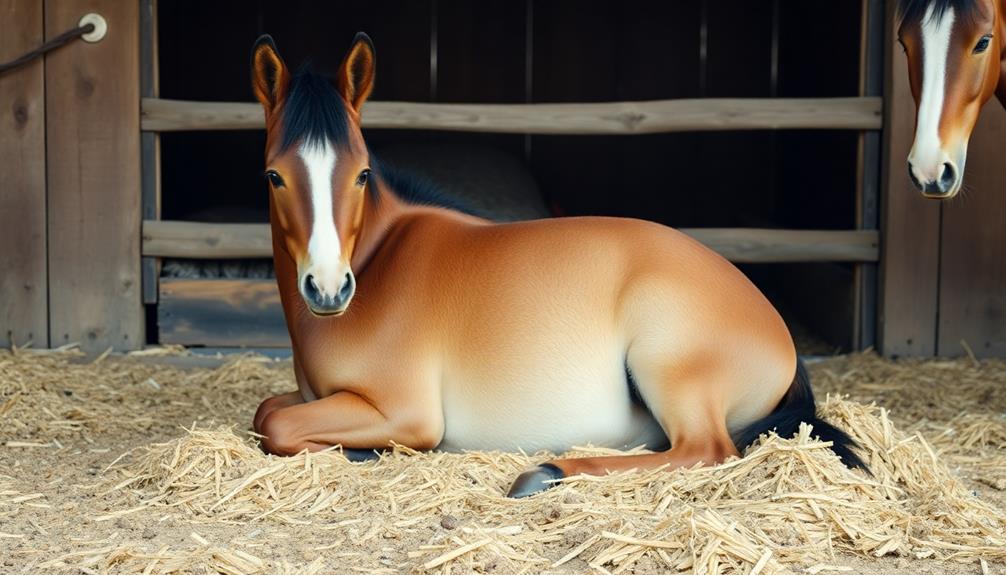
As the due date approaches, you'll want to be aware of the signs that indicate your miniature horse is about to foal. One of the first signs you might notice is an increase in rolling behavior, which typically starts 1-2 weeks before delivery. This suggests she's getting ready.
You'll also want to monitor her milk; a change from watery to a thick syrupy texture signals that foaling is likely within 24-48 hours.
Pay close attention to the mammary gland (bag) filling up, especially during feeding times. This is a strong indicator of readiness. You may also see wax on her teats, a clear sign she's very close—usually within the next 24 hours.
Additionally, check for softness around the tailset and vulva swelling, common physical signs that occur 24-48 hours prior to foaling.
If this is your mare's first time, it's crucial to observe these signs closely. Being prepared will help you guarantee a smooth delivery and that the umbilical cord is intact when she gives birth.
These indicators will guide you as you await the arrival of her new foal.
Monitoring the Foaling Process

When your miniature horse begins the foaling process, it's important to keep a close watch on her and the unfolding events. Monitoring the foaling process closely can help guarantee a safe delivery for both the mini mare and her foal.
Typically, once the water breaks, you should expect foaling to last around 20-30 minutes. If it doesn't progress within this timeframe, don't hesitate to call for veterinary assistance.
During delivery, the foal should present with its feet first, followed closely by the nose. This position is critical to reduce complications.
After birth, the newborn foal should right itself within five minutes and attempt to stand within thirty minutes. This is fundamental for its development and health.
Within 2-3 hours post-birth, the foal should nurse to receive important colostrum for immunity. If nursing doesn't happen within this period, it's necessary to intervene.
In the days leading up to foaling, observe your mini mare for increased rolling behavior and changes in milk consistency. These signs can indicate that the foal's arrival is imminent, allowing you to be prepared for the exciting event.
Post-Foaling Care Essentials

After your miniature horse foals, you need to treat the umbilical cord immediately with iodine or Novalsan to prevent infection.
Keep a close eye on the foal to guarantee it nurses within the first few hours for essential colostrum intake.
Regularly check its temperature and heart rate to monitor overall health and catch any potential issues early.
Essential Health Monitoring
Essential health monitoring right after foaling is essential for ensuring both the mare's and foal's well-being. Start by treating the mare with paste Ivermectin to prevent potential scours in the foal.
Once the foal is born, keep an eye on its sucking reflex; it needs to consume colostrum within 2-3 hours for proper immunity.
Next, monitor the foal's progress in passing meconium within 24 hours of birth. If it struggles, you may need to administer an enema.
Regular checks on the foal's body temperature are important; it should range between 99-102°F. Also, keep track of its heart rate, which averages around 70 beats per minute in the first five minutes.
This health monitoring applies not only to the foal but also to the mare, ensuring she's recovering well.
Umbilical Cord Treatment
Proper care of the umbilical cord is vital for the foal's health following birth. After delivery, treat the umbilical cord with iodine or Novalsan to help prevent infection and promote healing. Always make certain the umbilical cord breaks naturally during foaling for ideal detachment.
You'll need to monitor the area around the umbilical cord for any signs of swelling or discharge, as these could indicate complications. In the first few hours post-birth, keep a close watch on the foal to guarantee it's nursing properly and that the umbilical cord site remains clean and dry.
Here's a quick reference table for your needs:
| Monitoring Task | Frequency |
|---|---|
| Inspect umbilical cord | Every few hours |
| Check for swelling/discharge | Every few hours |
| Clean area with iodine/Novalsan | Once daily for several days |
Continue regular checks on the foal's umbilical cord site for several days to verify proper healing and to prevent any potential infections. Your diligence during this time is essential for your foal's well-being.
Foal Nursing and Health
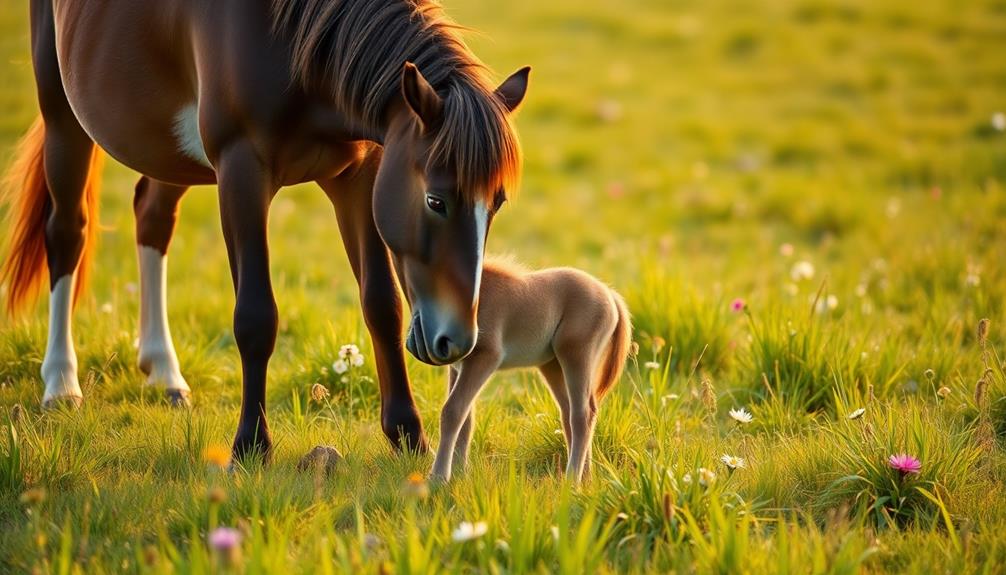
After your foal is born, it's vital they consume colostrum within the first few hours to get essential immunities.
You'll want to keep an eye on their nursing habits, as they typically nurse every 1-2 hours in those early days.
Regularly monitoring their weight and growth will help guarantee they're thriving and getting the nutrition they need from their mother's milk.
Colostrum Importance for Immunity
Understanding the fundamental role of colostrum in a foal's early life can greatly impact their health and survival. Colostrum is the first milk produced by the mare after foaling, packed with antibodies and nutrients essential for your foal's immunity. It's critical that your foal consumes this rich substance within 2-3 hours of birth to guarantee they receive adequate immunoglobulins, which protect them against diseases.
| Colostrum Benefits | Consequences of Deficiency |
|---|---|
| High levels of antibodies | Compromised immunity |
| Important nutrients | Increased vulnerability to infections |
| Supports early growth | Risk of illness |
| Promotes strong development | Potential long-term health issues |
If your foal struggles to nurse, immediate intervention is necessary. You might need to take into account a blood transfusion of colostrum from another mare. Keep a close eye on your foal's nursing behavior, as the sucking reflex is a key indicator of their health. Making sure your foal gets the colostrum they need is a fundamental step in safeguarding their future well-being.
Nursing Timing and Frequency
Nursing promptly and frequently is essential for a foal's health and development. Your foal should start nursing within 2-3 hours after birth to receive the vital colostrum that builds immunity.
It's important to monitor nursing timing and frequency, as regular nursing is key to their growth. Here are three significant points to contemplate:
- Sucking Reflex: Check your foal's sucking reflex shortly after birth. If they don't respond, it could indicate health issues, like being a "dummy foal."
- Nursing Frequency: Make sure your foal nurses every 1-2 hours during the first few days. This regular intake is necessary for proper nutrition and weight gain.
- Intervention: If your foal struggles to nurse, let me know right away. Immediate intervention is important to guarantee they receive adequate nutrition.
Adequate nursing behavior will show in your foal's weight gain and overall vitality within the first few days post-birth.
Monitoring Foal Health Status
Monitoring your foal's health status closely in the days following birth is essential for guaranteeing their well-being. Foals must consume colostrum within 2-3 hours after birth to receive essential immunities. If they fail to do so, you might face the need for a blood transfusion.
Right after birth, watch for a sucking reflex; foals should nurse successfully within three hours. If they struggle, don't hesitate to intervene.
During the first four days, keep an eye on their body temperature, which should be between 99-102°F. Significant deviations can indicate potential infections or illnesses, so it's important to monitor this closely.
Foals typically pass meconium within 24 hours; if they seem to struggle, an enema may be necessary.
Additionally, regular monitoring of urination frequency is important. Expect the first urination to occur around 8.5 hours after birth. This is a good indicator of hydration and overall health.
Mare and Foal Bonding
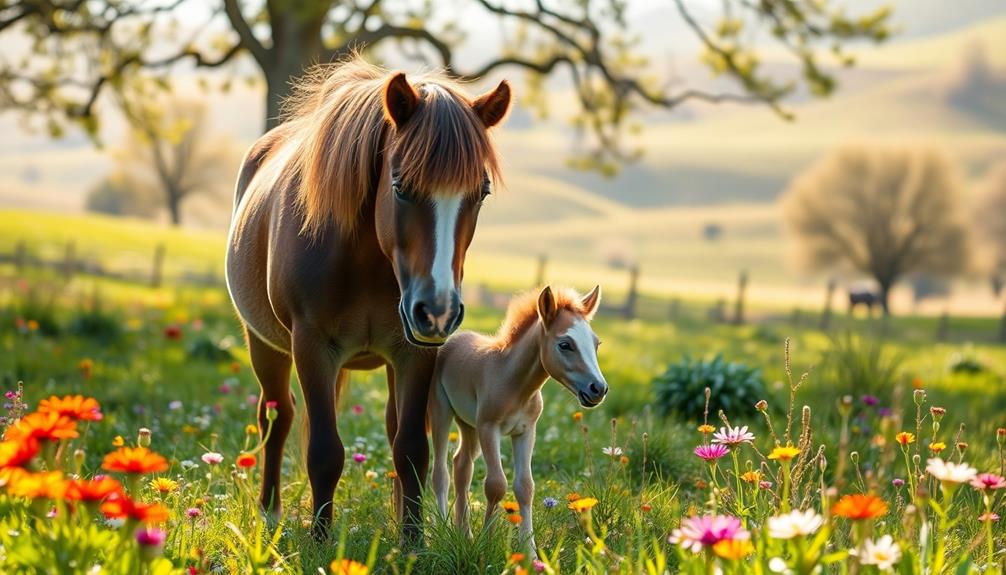
A strong bond between a mare and her foal is essential for the foal's development and well-being. To foster this connection, it's important to provide the right environment during the bonding period.
Here are three key steps you can take:
- Separate from Others: Keep the mare and foal away from other mares and foals for a few days to a week. This separation allows the foal to imprint on its mother, setting the stage for a solid relationship.
- Observe Carefully: When introducing the mare and foal to others, monitor the interactions closely. Other mares may show interest in bonding with the new foal, which can disrupt the mother-foal relationship.
- Encourage Calm Interactions: Minimize stress during this bonding phase. Calm interactions enable the mare to exhibit nurturing behaviors, such as grooming and protecting her foal, which are vital for the foal's emotional and physical development.
Equipment for Monitoring Pregnancies

When it comes to monitoring a miniature horse's pregnancy, having the right equipment can make all the difference. One essential tool is the Breeder Alert system, which detects when a mare lies down and sends beeper alerts directly to you. This allows for timely monitoring of the foaling process, ensuring you're prepared for those vital moments.
Another invaluable piece of equipment is an Arlo camera system, enabling remote monitoring from various devices. With ten strategically positioned cameras throughout the barn and maternity area, you can keep an eye on your mare's progress. These cameras offer extensive coverage, capturing key moments leading up to and during foaling.
Don't forget about portable cameras, which can be easily relocated outside. This way, you can monitor mares in their natural environment during the day.
Regular checks using this monitoring equipment help you identify potential issues early, contributing to the overall health and safety of both the mare and foal. With the right tools, you'll feel more confident and prepared as your miniature horse approaches the big day.
Frequently Asked Questions
How to Tell When a Mini Horse Is About to Give Birth?
To tell when your mini horse is about to give birth, watch for signs like mammary gland changes, vulva swelling, increased rolling behavior, and changes in milk consistency. Move her to a maternity ward for close observation.
How Do You Know When a Mini Horse Is Foaling?
You'll know your mini horse is foaling when you see signs like increased rolling, mammary gland development, wax on teats, and changes in milk texture. Watch for tailset softness and vulva swelling too.
How Long Is the Gestation Period for Mini Horses?
The gestation period for mini horses typically lasts about 11 months and 5 days, but it can range from 320 to 365 days. Keep track of each mare's breeding date for accurate due date predictions.
How Long Are Minis Pregnant?
Did you know miniature horses can be pregnant for about 330 days? You'll find their gestation typically ranges between 10 to 12 months, so keeping track of your mare's breeding dates is essential for accurate predictions.
Conclusion
As you navigate the journey of your miniature horse's pregnancy, remember that each moment is filled with excitement and anticipation. By keeping an eye on the signs of foaling and ensuring proper care, you can help create a safe and nurturing environment for both mare and foal. Isn't it incredible to think about the bond that's about to blossom? With your love and attention, you'll witness a beautiful new life entering the world right before your eyes.





